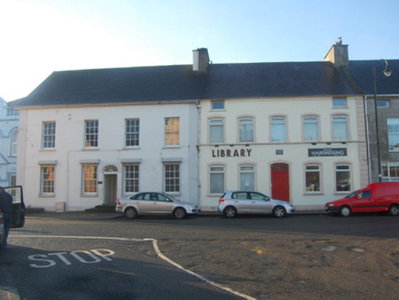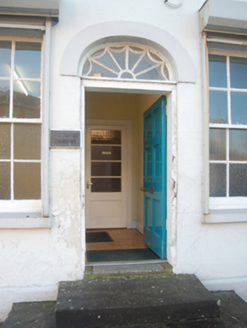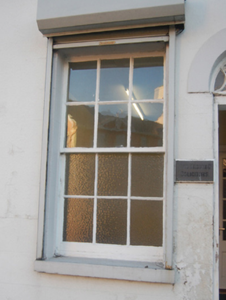Survey Data
Reg No
40833011
Rating
Regional
Categories of Special Interest
Architectural
Original Use
House
In Use As
Office
Date
1750 - 1790
Coordinates
225745, 402861
Date Recorded
11/10/2010
Date Updated
--/--/--
Description
Attached end-of-terrace five-bay two-storey house, built c. 1770. Now in use as offices (ground floor) with accommodation (apartments) over. Pitched artificial slate roof (fibre) having rendered, chimneystack to party wall to north shared with adjacent building (see 40833012), and with surviving cast-iron rainwater goods. Smooth rendered ruled-and-lined walls over projecting smooth rendered plinth course, and with smooth rendered strips\vertical bands to the corners of the front elevation (east). Square-headed window openings with cut stone sills, and with six-over-six pane timber sliding sash windows over. Metal security shutters at ground floor level. Central segmental-headed doorcase having replacement timber door, and spider’s web fanlight over having smooth rendered surround. Road-fronted to the south corner of the Diamond to the centre of Raphoe.
Appraisal
This well-proportioned house, of mid-to-late eighteenth-century appearance, retains its original form and character despite some modern alterations. Its visual appeal is enhanced by the retention of early timber sliding sash windows while the doorway with elegant fanlight over provides an attractive central focus. This central doorway and the classical proportions of the fenestration to the front elevation is a characteristic feature of mid and late Georgian townhouses such as this. The loss of the natural slate roof and the installation of security shutters to the ground floor windows fails to detract substantially from its appeal and integrity. This building forms an integral element of an interesting collection of eighteenth and nineteenth-century houses surrounding the Plantation-era Diamond at Raphoe, and is an integral element of the built heritage of the town. The buildings of the Diamond are of greater significance together than on their own, resulting from their collective townscape character.





